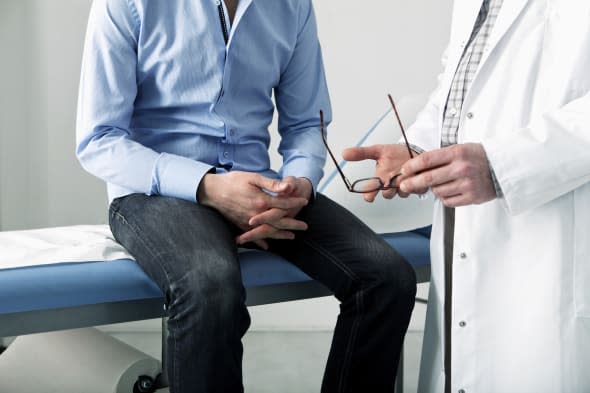Testicular cancer: what you need to know

Testicular cancer is relatively rare, with around 2,300 cases diagnosed in the UK each year. It is unusual in that it mainly affects younger men aged between 15 and 49. Find out how to spot the symptoms and the treatment options available...
Related Searches
Risk factors
Sometimes testicles fail to move from the body to the scrotum and surgery is required. Boys who have had this surgery have been shown to suffer from testicular cancer more frequently.
Risk increases significantly if the surgery is carried out after the age of 13. It is double the normal rate before that age and five time the rate after. Previously suffering from the disease is a strong indicator of increased likelihood to get it in the other testicle, while a family history of the disease increases risk. Long-term smokers are twice as likely as the average to get the disease. Men over 6ft tall are also at more risk, as are those with fertility problems and Aids/HIV sufferers.
%VIRTUAL-AFCSponserAds%Symptoms
The most-common symptom is a lump or swelling in one testicle. Others include a dull ache or sharp pain (which may come and go), a feeling of heaviness in the scrotum, fluid collecting in there and general feelings of fatigue and unwellness.
If the disease spreads to other parts of the body it is known as metastatic cancer. The most-common areas it goes to are the lymph nodes in the abdomen or the lungs. Symptoms of this include persistent coughing, spitting or coughing up blood, shortness of breath, enlargement of male breasts, a lump or swelling in the neck and lower back pain.
Treatment
Once you've been diagnosed with the disease the treatment is nearly always surgical removal of the affected testicle – known as an orchidectomy. If the illness was in stage one, this will be followed by chemotherapy and perhaps radiotherapy. For stages two, three and four the treatment is similar – but with additional surgery perhaps required to remove cancer that has spread to other parts of the body.
Patients' sex lives and their ability to father children may not be affected by the removal of a single testicle, though chemotherapy can cause temporary infertility. Permanent infertility can follow more intense treatments – and of course is a result of the removal of both testicles. Testosterone therapy can be provided to people who have had both testicles removed, to help maintain their sex drive.
Prevention, checking and prognosis
There is no way to prevent testicular cancer, although stopping smoking is a good move. It's important to catch the disease early – so men are encouraged to check for unexpected lumps after a warm bath or shower. Stand in front of a mirror and check for swelling, then roll the testicle in your hand. It should be smooth and oval-shaped – anything irregular is suspicious and you should go and see your GP as soon as possible.
Following treatment, the illness has a 25 to 30 per cent chance of returning – usually within two years.
Have you been diagnosed with testicular cancer? Leave a comment here...




